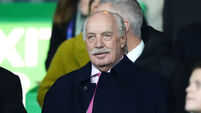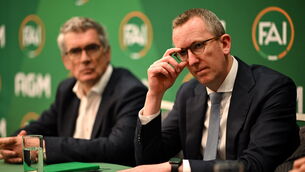Daniel Storey: The sport a child plays is not the one they play as a professional. Maradona was the exception

Memorabilia is seen outside the San Paolo stadium to commemorate soccer legend Diego Maradona, in Naples, Thursday, Nov. 26, 2020. Maradona died on Wednesday at the age of 60 of a heart attack in a house outside Buenos Aires where he recovered from a brain operation. (AP Photo/Alessandra Tarantino)
“I have a rational religion, and that’s Catholic Church, and I have a religion passed on my heart, passion, and that’s Diego Maradona.”
Those are the words of Alejandro Veron, one of two brothers who created the Church of Maradona, a religion which makes their hero the Father, Son and Holy Ghost. There are close to 200,000 followers, ten commandments and a Lord’s Prayer, adapted to match Maradona’s career. The religion celebrates Diego’s birthday as a holy day, and counts years according to the time since his birth. Maradona himself was unsurprisingly delighted.
The Verons’ church is, of course, slightly tongue-in-cheek, a glorified fan club rather than a serious sect, but religious symbolism is the only appropriate way to truly describe the adoration for Maradona in Argentina. The population loves Lionel Messi’s brilliance, but their true love is saved for only for one. Hearing those special three words is enough to send any resident of Buenos Aires into a passionate frenzy: Diego Armando Maradona.
Messi, for his own part, is humble (or perhaps clever) enough to reject the comparisons. “Even if I played for a million years, I’d never come close to Maradona,” he said. “Not that I’d want to anyway. He’s the greatest there’s ever been.”
If Messi is the good boy — tax discrepancies aside — Maradona is their golden boy, El Pibe de Oro. Argentina sees him not as a symbol of debauchery and decline, but of the fight against oppression, the poor boy who became king. Maradona is the man fighting The Man, never afraid to challenge the system and representing the people. ‘And Give Joy to my Heart’ is a song written in honour of his performances at the 1986 World Cup.
To understand Maradona’s cultural impact, you have to understand the social unrest in Argentina during the late 1970s and early 1980s, the Guerra Sucia during which the military and security forces arrested and killed large swathes of left-wing activists and political dissidents. If football was the escapism, Maradona was the plane ticket to a far happier destination. Not only was his the fairytale story, but the leading role was played by the fairytale actor.
Growing up in a shack in Villa Fiorito, a suburb of Buenos Aires, Maradona’s childhood was extraordinarily hard. He had neither electricity nor running water, and there is a well-known story of a three-year-old Maradona having his life save by his uncle after falling in a sewage pit.
"There are many people who are scared to admit they come from a villa," Maradona said, "but not me, because if I hadn't been born in a villa, I wouldn't have been Maradona. If there was food you ate it, and if there wasn’t then you went hungry. But I had the freedom to play.”
There is no doubt that Villa Fiorito life toughened Maradona, but it also established his national pride and left-wing political affiliation. As a player in the national team at the 1986 World Cup, the No. 10 would sleep in an Argentina shirt. If that sounds like the behaviour of a naive, wide-eyed fan rather than professional football, Maradona was there to prove that the two need not be mutually exclusive.
First spotted as a child playing with a ball that he treasured as one of his few possessions, Maradona was taken to Argentinos Juniors for a trial where his natural ability astonished the club’s coaches.
“I was really struck by his talent and couldn't believe he was only eight years old,” Francisco Cornejo said. “In fact, we asked him for his ID card so we could check it, but he told us he didn't have it on him. We were sure he was having us on because, although he had the physique of a child, he played like an adult. When we discovered he'd been telling us the truth, we decided to devote ourselves purely to him."
Maradona’s first taste of the limelight was as a 12-year-old, performing juggling tricks for fans at half-time in Argentinos Juniors matches. The boy may have had little experience of life outside the shanty town, but the ambition was never in doubt: “My first dream is to play in the World Cup, and my second is to become a champion.”
If Maradona’s outlook on life made him the people’s champion, his style made him their king. To watch Diego in full flight was to watch the embodiment of South American football, sport in its most joyful form. Strip away the tactics, the systems, shapes and instructions, and you are left with a person and ball, enjoying one another’s company. To watch Maradona dribble, do kick-ups with an orange or to balance the ball on the back of his neck in training, was to watch someone bursting with joy.
One thing young players often fail to comprehend is that the sport they love as a child is not the sport they will play as a professional. There are sacrifices to be made, lessons to be learned, training drills to be practiced and strict diets to be followed. Maradona is the exception to that rule, for what he had could not be taught or honed. Asking Maradona to practice his shuttle runs would be like teaching Brian Lara to alter his unorthodox batting technique. You can mess with perfection, but it is ill-advised.
As a no. 10, Maradona was perfection. In a position demanding skill and poise far more than pace, he ruled his domain. His stocky frame and diminutive height made him impossible to shake off the ball through legal means, and his raw skill with the ball was far beyond any other player in the world. As Michel Platini once said: “What Zidane could do with a ball, Maradona could do with an orange.”
Maradona flourished most when he was embraced, warts and all. At Boca Juniors and Napoli, supporters loved their rogue and revelled in Maradona’s rebellious streak while both clubs knew better than to try and change him. Maradona’s misdemeanours, of which there were many, only brought him closer to supporters who recognised their own flaws.
One myth about Maradona is that his was a purely individual brilliance. Diego’s national pride and desire to be the best made him a popular choice as captain of the national team, for whom he regularly played through great pain. Although he was a supreme dribbler, Maradona was not a selfish player, as confirmed by teammate Jorge Valdano after his ‘Goal of the Century’ against England in 1986.
“Diego apologised to me after he scored the second goal against England,” Valdano said. “He could see me unmarked at the far post the whole way but he couldn’t find a gap to get the ball to me. The fact is I felt offended. It was an insult to my profession. I mean, even on a run like that he still has the time to look up and see me. As a player I was nothing compared to him. He was incredible.”
That quarter-final was Maradona in excelsis, the brilliance of that second goal clashing with the brazen cheek of the first.
Despite leading his country to World Cup victory in 1986, it was arguably in 1990 that Maradona produced his greatest feat. In Mexico he was at his peak, but Italia ‘90 took every ounce of his mental strength. With his ankles swollen and legs permanently bruised from the rigours of weekly meetings with Serie A defenders, Maradona survived on an (almost literal) diet of Cortisone injections and cocaine, although the latter would only be detected later. Poor in his first three games after limping through with injury, Maradona dragged Argentina to the final. The birth certificate might have proved that the body was 29, but El Diego felt at least double that age.
***
Maradona eventually succumbed to retirement in 1998, but was effectively finished four years earlier after his doping ban from the 1994 World Cup. If anything, it’s impressive he lasted as long; Maradona had first become addicted to cocaine in 1983, seven years before it truly began to affect his game. As with Paul Gascoigne, there is a melancholic irony to the majestic talent actually causing the downfall; so talented was Maradona, his ability masked the addiction.
Maradona’s post-playing career fairly depicted him as a caricature of a man, the Spitting Image puppet of the fallen star. He was riddled with addiction to drugs, drink and food in various combinations, undergoing gastric bypass surgery and suffering the effects of alcohol abuse and a cocaine-induced heart attack that almost took his life at the age of just 43. But El Diego was in no mood for regret.
“I’ve packed 70 years into my 40,” he said in 2001. “I’ve seen it all. I went from a dirt track in Villa Fiorito to the top of the world. When I got there, I had to figure out for myself what to do. Nobody ever told me what it would be like or how to handle it.”
As with Gascoigne and George Best, Maradona suffered from the public assumption that breathtaking natural talent comes with an instruction manual.
The BBC’s South American football expert Tim Vickery made an excellent point on Maradona’s post-career troubles. Diego has always been an addict; his first addiction was just football. His problems came when he mastered it.
“I tried to find happiness playing football, and through it I tried to bring happiness to others,” Maradona once said. “Football is the most beautiful game in the world. Yes, I made errors. and I paid the price, but you can never tarnish football.”
Mistakes, he made a few. But El Diego did things his way. There exists an entire nation that doesn’t just agree with that sentiment but defines its culture by it. Whatever role Maradona played in his own demise, Argentina will always anoint him as their king. He is their everyman, their lower-class street urchin who became the best player in the world.









